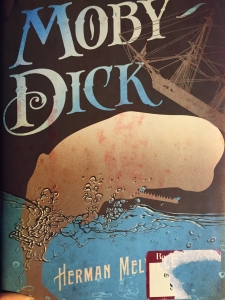 Moby Dick wasn’t on my high school reading list, and I’m grateful. At seventeen I never could have appreciated the novel about revenge, obsession, life and whales.
Moby Dick wasn’t on my high school reading list, and I’m grateful. At seventeen I never could have appreciated the novel about revenge, obsession, life and whales.
Today, I loved it, though I can’t recommend it. Whole sections were a slog, parts were dull, others I couldn’t put down, images were beautiful, comments were poignant and powerful, passages were constantly contradictory, at times I’d reread a section four times not sure what the point was, but positive if I could figure it out, the passage would be filled with meaning. Melville created moments and pictures that I hope I’ll remember for years.
But one part may have stood out more to me than most Moby Dick readers. It may prove that I am overly obsessed with fascia—the connective tissue that runs through our bodies like sausage casings around every muscle and organ. That description is merely the tip of the iceberg. There is so much more to fascia. Call me fascia-fixated.
About halfway through I started reading with renewed vigor when I realized Melville was unknowingly describing the connective tissue and fascia of a whale. Actually, it shouldn’t come as a surprise because there is nothing about a whale that Melville didn’t describe in great detail.
Melville describes parts of a sperm whale being “naturally divided by an internal wall of a thick tendinous substance.”
“The lower subdivided part, called the junk, is one immense honeycomb of oil, formed by the crossing and re-crossing, into ten thousand infiltrated cells, of tough elastic white fibers throughout its whole extent.”
Fascia is everywhere.
While for years we were adrift, ignoring fascia, only in the past thirty years starting to appreciate how significant and magnificent it is, Melville was admiring it in 1851.
In chapter 77, when describing the whale’s tail (yes, there is a whole chapter devoted to whale tails) he explains, “The entire member seems a dense webbed bed of welded sinews…three distinct strata compose it…” He unwittingly gives fascia credit for the tails power, strength, elasticity, graceful flexion and easy undulations (his words, not mine). And though he can’t explain it, he feels like the whale’s sense of touch is concentrated there.
While fascia is all connected, we do divide fascia into three parts—deep, superficial and visceral. It also houses many of our sensory nerve endings, so it can be highly sensitive. And fascia may very well be our elasticity powerhouse. It may be the part of our body that enables a spring in our step, the leap of a dancer and the bounding of any animal. The description Melville rattled off may be the best way to explain what fascia is capable of—power and grace combined.
When we try to look for ways to describe fascia—a spider web the best example I’ve seen so far—we should turn to Melville for the words. He’s the beacon we’ve all been sailing past.
Melville’s secret love of fascia may not be enough to make you weak in the knees and want to read the tome. So if you need more to fall head over heels, I’m pretty sure he and Joe Pilates would have been fast friends. If Meghan Trainor is all about the bass than Joe Pilates was all about the spine, and so was Melville.
He goes so far as to suggest that our vertebrae are all little, undeveloped skulls—a bit much for sure (although a great premise for some b-horror movie). But sometimes he gets it spot on. “…phrenologists have omitted an important thing in not pushing their investigations from the cerebellum through the spinal canal. For I believe that much of a man’s character will be found betokened in his backbone…I rejoice in my spine.”
Pilates put it this way, “A man is as young as his spinal column…If your spine is inflexibly stiff at thirty you are old. If it is completely flexible at sixty, you are young.”
When was the last time you rejoiced in your spine?
Like Joe, Melville attributes the whales great health and stamina to an “abundance of exercise, always out of doors.”
Am I reading too much into it? Looking too deep? I can’t say I understood Moby Dick or even that I went away from it with the right message, but what I do know and didn’t miss is that Melville was ahead of his time when it came to fascia and the love of our spine. For fascia may be a major player in discovering how to move better and heal our own bodies. Fascia continues to fascinate because it may be our true north, pointing us in a direction toward optimal health.
